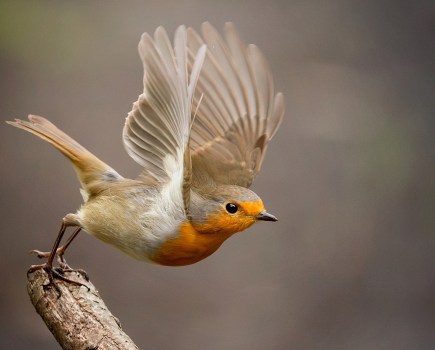The Wildlife Photographer of the Year 2022 competition saw 38,975 entries from 93 different countries put through an intensive process of anonymous judging by an international panel of experts. The judges are looking for originality, narrative, technical excellence and ethical practice. From these entries, the 19 category winners aim to highlight the natural world in all its finest majestic wonder and diversity.
Overall winner, American photographer Karine Aigner, is the fifth woman to take home the grand title in the competition’s 58-year history. Her image, a close-up of cactus bees, photographed from a bee-level point of view, was taken at a Texas ranch.
Meanwhile, 16-year-old Katanyou Wuttichaitanakorn from Thailand has been awarded the Young Wildlife Photographer of the Year prize for his intriguing abstract image of a baleen whale capturing its very small prey.
Director of the Natural History Museum, Dr Doug Gurr, says of the competition, ‘Wildlife photographers offer us unforgettable glimpses into the lives of wild species, sharing unseen details, fascinating behaviours and front-line reporting on the climate and biodiversity crises. These images demonstrate their awe of and appreciation for the natural world and the urgent need to take action to protect it.’
Wildlife Photographer of the Year 2022 winner
The Big Buzz by Karine Aigner, USA
Winner, Behaviour: Invertebrates and Wildlife Photographer of the Year
Sony A7R III, Laowa 24mm f/14 2x macro probe lens, 1/1000sec, ISO 6400; Profoto strobe and wireless trigger
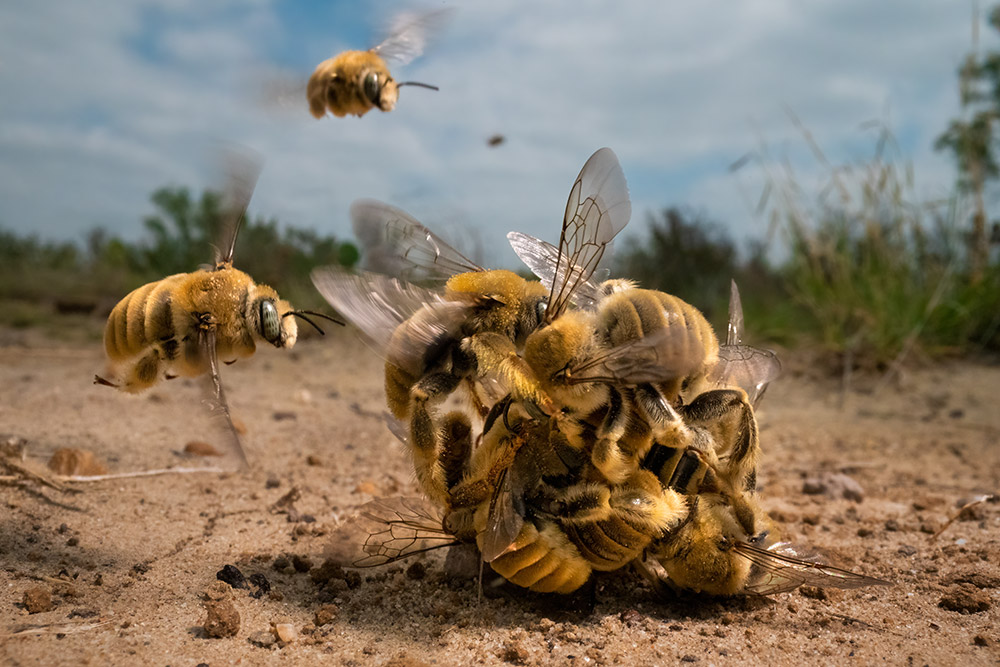
The Big Buzz by Karine Aigner, USA. Winner, Behaviour: Invertebrates and Wildlife Photographer of the Year 2022. Sony A7R III, Laowa 24mm f/14 2x macro probe lens, 1/1000sec, ISO 6400; Profoto strobe and wireless trigger. © Karine Aigner/Wildlife Photographer of the Year
Karine captured this flurry of activity as a ball of cactus bees spun over the hot sand of a Texas ranch. After a few minutes, the pair at the centre of the ball – a male clinging to the only female bee in the scrum – flew away to mate. The world’s bees are impacted by habitat loss, pesticides and climate change. 70% of bee species nest underground, so it’s increasingly important that natural soil is left undisturbed.
Chair of the judging panel, Rosamund Kidman Cox OBE, says, ‘The sense of movement and intensity is shown at bee-level magnification and transforms what are little cactus bees into big competitors for a single female.’
Young Wildlife Photographer of the Year 2022 winner
The Beauty of Baleen by Katanyou Wuttichaitanakorn, Thailand
Winner, 15-17 Years and Young Wildlife Photographer of the Year
Canon EOS 90D, Sigma 150-600mm f/5-6.3 lens, 1/6400sec at f/6.3 (-1e/v), ISO 640
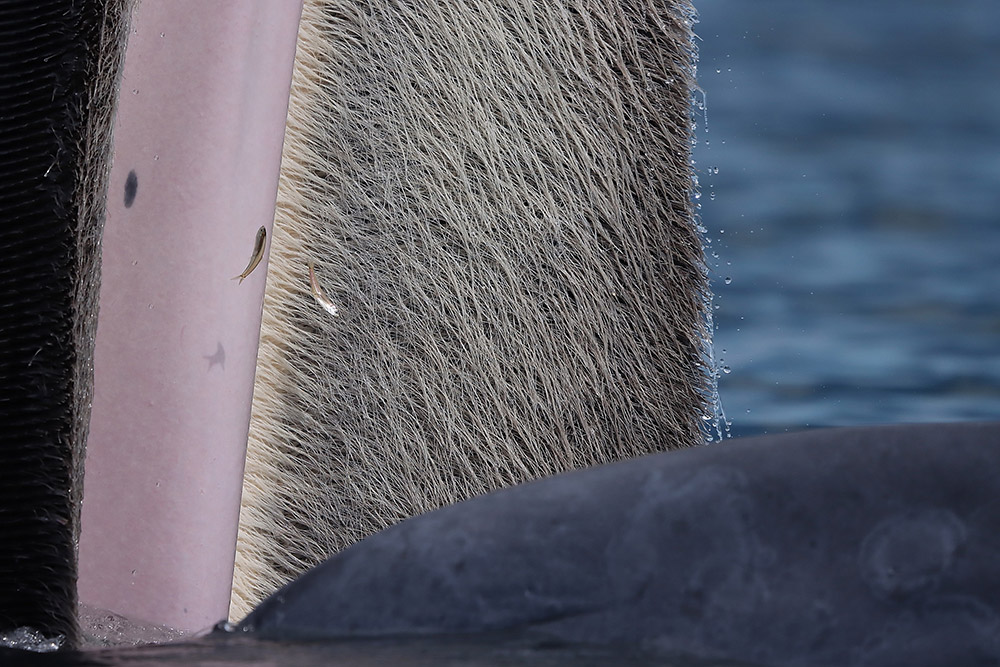
The Beauty of Baleen by Katanyou Wuttichaitanakorn, Thailand. Winner, 15-17 Years and Young Wildlife Photographer of the Year 2022. Canon EOS 90D, Sigma 150-600mm f/5-6.3 lens, 1/6400sec at f/6.3 (-1e/v), ISO 640. © Katanyou Wuttichaitanakorn/Wildlife Photographer of the Year
Intrigued by the contrasting colours and textures of a Bryde’s whale, which is surfacing close by, Katanyou captured this fascinating abstract taken at the Upper Gulf of Thailand, Phetchaburi, Thailand. The tour boat Katanyou was travelling on turned off its engine as the whale appeared close by. This required a steady hand to capture this close-up composition as the boat rocked in the swell. This type of whale has up to 370 pairs of grey-coloured plates of baleen growing inside their upper jaws. The plates, which are made of keratin – the same protein which also forms human hair and nails – are used to filter small prey from the ocean.
See more Wildlife Photographer of the Year 2022 winners below
Animals in their Environment
Winner: Spectacled Bear’s Slim Outlook by Daniel Mideros, Ecuador
Canon EOS 7D Mark II, 18-55mm f/3.5 lens, 1/160sec at f/14, ISO 400; 2x Nikon SB-28 flashes; Camtraptions camera-trap system
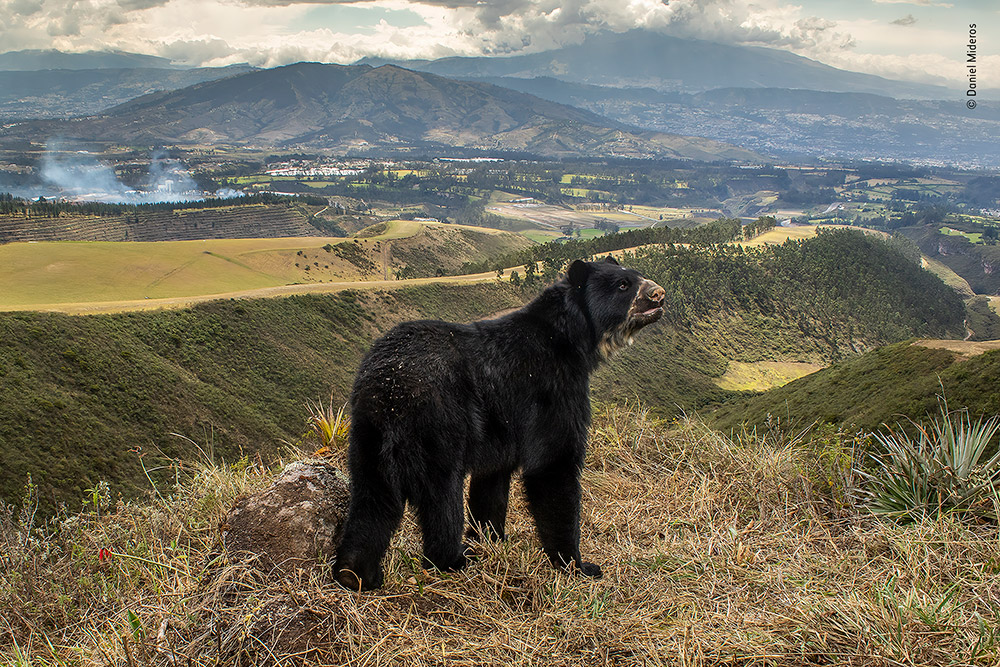
Spectacled Bear’s Slim Outlook by Daniel Mideros, Ecuador. Animals in their Environment Winner. Canon EOS 7D Mark II, 18-55mm f/3.5 lens, 1/160sec at f/14, ISO 400; 2x Nikon SB-28 flashes; Camtraptions camera-trap system. © Daniel Mideros/Wildlife Photographer of the Year
This poignant portrait image highlights the inhabitant of a disappearing habitat at Peñas Blancas, Quito, Ecuador. Setting up camera traps along a wildlife corridor used to reach high-altitude plateaus, Daniel’s aim was to show the disappearing natural landscape with the bear framed at the heart of the image.
These bears, which are found from western Venezeula to Bolivia, have suffered greatly from habitat fragmentation and loss. Space for wildlife is increasingly under threat as humans continue to build and farm.
Animal Portraits
Winner: Puff perfect by José Juan Hernández Martinez, Spain
Nikon D3S + Sigma 150–600mm f5–6.3 lens at 600mm; 1/1000 sec at f6.3; ISO 800; Manfrotto tripod + Benro head
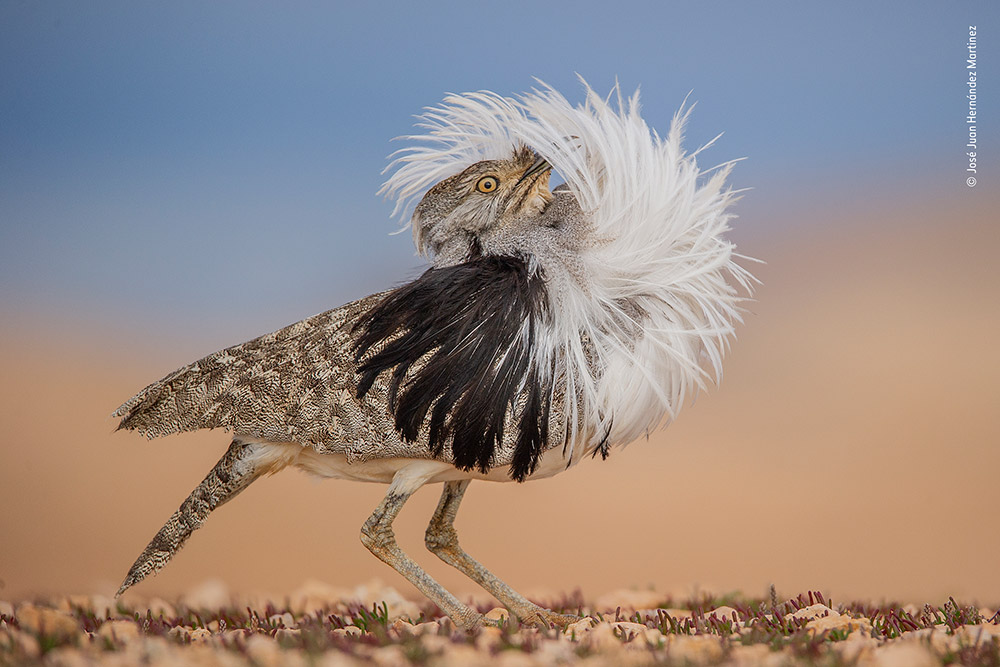
Puff perfect by José Juan Hernández Martinez, Spain. Animal Portraits Winner. Nikon D3S + Sigma 150–600mm f5–6.3 lens at 600mm; 1/1000 sec at f6.3; ISO 800; Manfrotto tripod + Benro head. © José Juan Hernández Martinez/Wildlife Photographer of the Year
José Juan Hernández Martinez witnesses the dizzying courtship display of a Canary Islands houbara. José arrived at the houbara’s courtship site at night. By the light of the moon, he dug himself a low hide. From this vantage point he caught the bird’s full puffed-out profile as it took a brief rest from its frenzied performance. A Canary Islands houbara male returns annually to its courtship site to perform impressive displays. Raising the plumes from the front of its neck and throwing
its head back, it will race forward before circling back, resting just seconds before starting again.
Photojournalism
Winner: Ndakasi’s Passing by Brent Stirton, South Africa
Canon EOS R5, 24-70mm f/2.8 lens, 1/160sec at f/2.8, ISO 3200
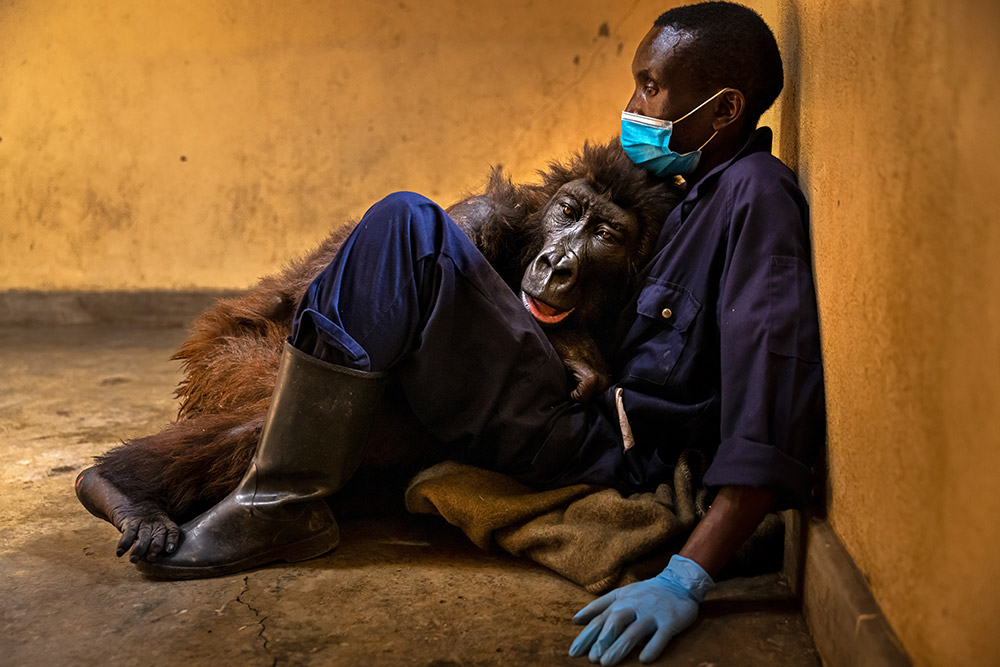
Ndakasi’s Passing by Brent Stirton, South Africa. Photojournalism Winner. Canon EOS R5, 24-70mm f/2.8 lens, 1/160sec at f/2.8, ISO 3200. © Brent Stirton/Wildlife Photographer of the Year
Taken at the Senkwekwe Gorilla Orphanage Center, Virunga National Park in the Democratic Republic of Congo, Brent Stirton’s powerful and poignant photograph captures the last moments of a much-loved mountain gorilla.
Brent first photographed Ndakasi as a two-month-old when her troop was killed by a powerful charcoal mafia as a threat to the park rangers. Here, we see her rescuer and caregiver of 13 years, ranger Andre Bauma, cradling her as she dies. Mountain gorilla numbers have quadrupled to more than 1,000 in the past 40 years thanks to the unrelenting and dedicated conservation efforts which focus on the daily protection of individual gorillas.
Natural Artistry
Winner: Heavenly Flamingos by Junji Takasago, Japan
Nikon Z7, 800-400mm f/4-5.6 lens at 400mm, 1/3200sec at f/10 (+0.7 e/v), ISO 800
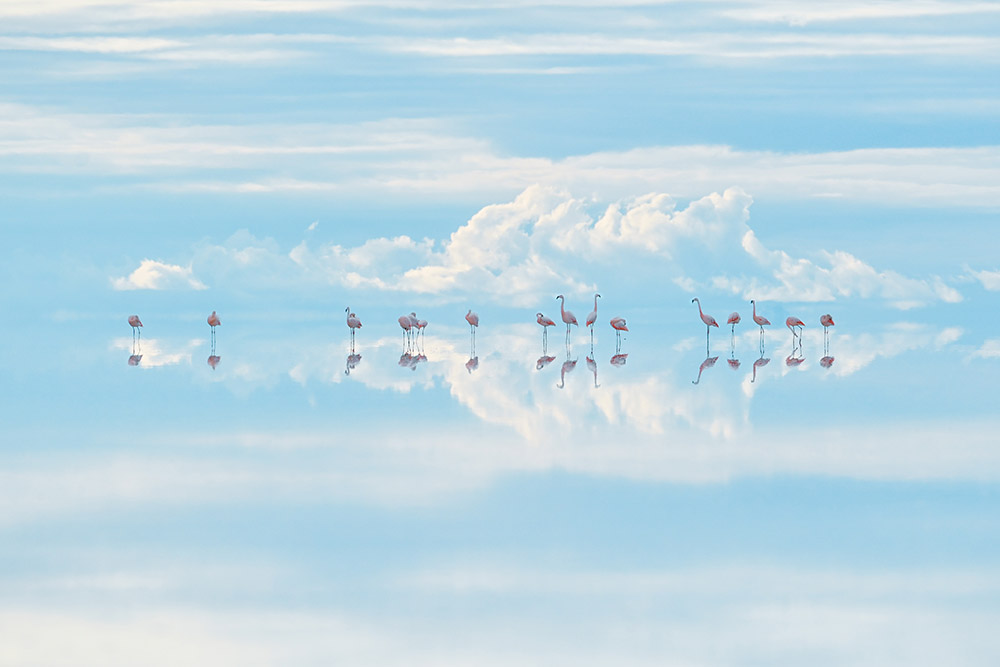
Heavenly Flamingos by Junji Takasago, Japan. Natural Artistry Winner. Nikon Z7, 800-400mm f/4-5.6 lens at 400mm, 1/3200sec at f/10 (+0.7 e/v), ISO 800
© Junji Takasago/Wildlife Photographer of the Year
To capture this shot, Junji had to power through altitude sickness. The resulting dream-like scene of a preening group of Chilean flamingos is beautiful in its composition.
It was taken at Salar de Uyuni, high in the Andes, which is the world’s largest salt pan. It’s also one of Bolivia’s largest lithium mines, which threatens the future of these flamingos as the material is used in batteries for electronics. Decreasing demand for lithium, by recycling old electronics, will help areas like this stay safe for its natural inhabitants.
Oceans: The Bigger Picture
Winner: New life for the tohorā by Richard Robinson, New Zealand
Canon EOS 5DS R + 8–15mm f4 lens at 15mm; 1/640 sec at f4;ISO 1600; Aquatica housing
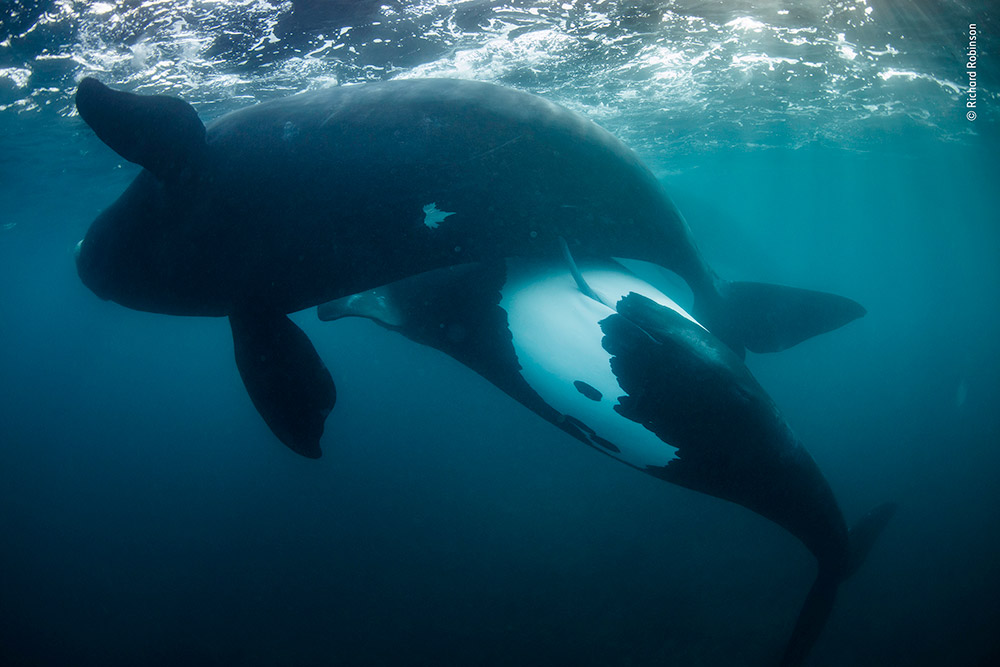
New life for the tohorā by Richard Robinson, New Zealand. Oceans: The Bigger Picture Winner. Canon EOS 5DS R + 8–15mm f4 lens at 15mm; 1/640 sec at f4;ISO 1600; Aquatica housing. © Richard Robinson/Wildlife Photographer of the Year
Richard Robinson captures a hopeful moment for a population of whales thathas survived against all odds.Hindered by poor visibility, Richard used a polecamto photograph the whalesgradually moving towards his boat. Pushing his camera to its limits in the darkwater, he was relieved to find the image pin-sharp and the moment ofcopulation crystallised in time.
When ready to mate, the female southern rightwhale rolls onto its back,requiring the male to reach its penis across the female’s body. Known by theMāori as tohorā, the New Zealand population was hunted to near extinction inthe 1800s, so every new calf offers new hope.Shot under New Zealand Department of Conservation permit #84845-MAR
Behaviour: Amphibians and Reptiles
Winner: The Bat-snatcher by Fernando Constantino Martínex Belmar, Mexico
Nikon D800, 105mm f/2.8 lens, 1/200sec at f/9, ISO 125; Nikon SB-700 flash; red flashlight

The Bat-snatcher by Fernando Constantino Martínex Belmar, Mexico. Behaviour: Amphibians and Reptiles. Winner. Nikon D800, 105mm f/2.8 lens, 1/200sec at f/9, ISO 125; Nikon SB-700 flash; red flashlight. © Fernando Constantino Martínex Belmar/Wildlife Photographer of the Year
Fernando had to wait in darkness for this scene to unfold in front of this camera. Here we see a Yucatan rat snake snapping up a bat. In order to keep an eye on what was happening, Fernando used a red light, to which both bats and snakes are less sensitive. He had just seconds to get the shot as the rat snake retreated into its crevice with its bat prey.
Each evening, at sundown, thousands of bats leave the Cave of the Hanging Snakes in Kantemo, Quintana Roo, Mexico, for the night’s feeding. At the same time, hungry rat-snakes emerge, hanging from the roof to snatch their prey in mid-air.
Urban Wildlife
Winner: House of Bears by Dmitry Kokh, Russia
DJI Mavic 2 Pro, Hasselblad L1D-20c, 28mm f/2.8 lens, 1/160sec at f/2.8, ISO 640
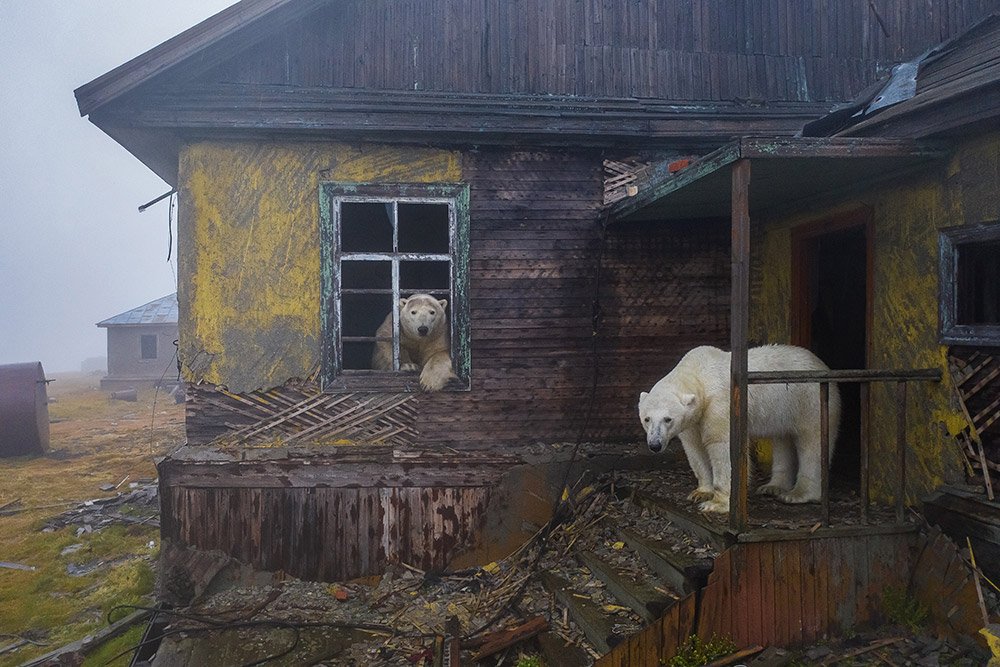
House of Bears by Dmitry Kokh, Russia. Urban Wildlife Winner. DJI Mavic 2 Pro, Hasselblad L1D-20c, 28mm f/2.8 lens, 1/160sec at f/2.8, ISO 640. © Dmitry Kokh/Wildlife Photographer of the Year
This astonishing and haunting shot shows polar bears shrouded in fog at the long-deserted settlement on Kolyuchin, Russia. While seeking shelter from a storm, photographer Dmitry spotted the polar bears roaming among the buildings. As they explored every window and door, Dmitry used a low-noise drone to take a picture which could easily be a still from a post-apocalyptic movie. These normally solitary bears usually migrate further north in the summer, following the retreating sea ice that they depend on for hunting seals, their main food.
Underwater
Winner: Shooting star by Tony Wu, USA/Japan
Nikon D850 + 105mm f2.8 lens; 1/250 sec at f18; ISO 320; Nauticam housing; Backscatter Mini Flash 1 + Inon S2000 + Z240 strobes; RGBlue compact tripod

Tony Wu watches the electrifying reproductive dance of a giant sea star. As the surrounding water filled with sperm and eggs from spawning sea stars, Tony faced several challenges. Stuck in a small, enclosed bay with only a macro lens for photographing small subjects, he backed up to squeeze the undulating sea star into his field of view, in this galaxy-like scene. The ‘dancing’ posture of spawning sea stars rising and swaying may help release eggs and sperm, or may help sweep the eggs and sperm into the currents where they fertilise together in the water.
Portfolio Award
Winner: Under Antarctic Ice by Laurent Ballesta, France
Nikon D810, 13mm f/2.8 lens, 1/13sec at f/16, ISO 800; Seacam housing; 2x Seacam strobes
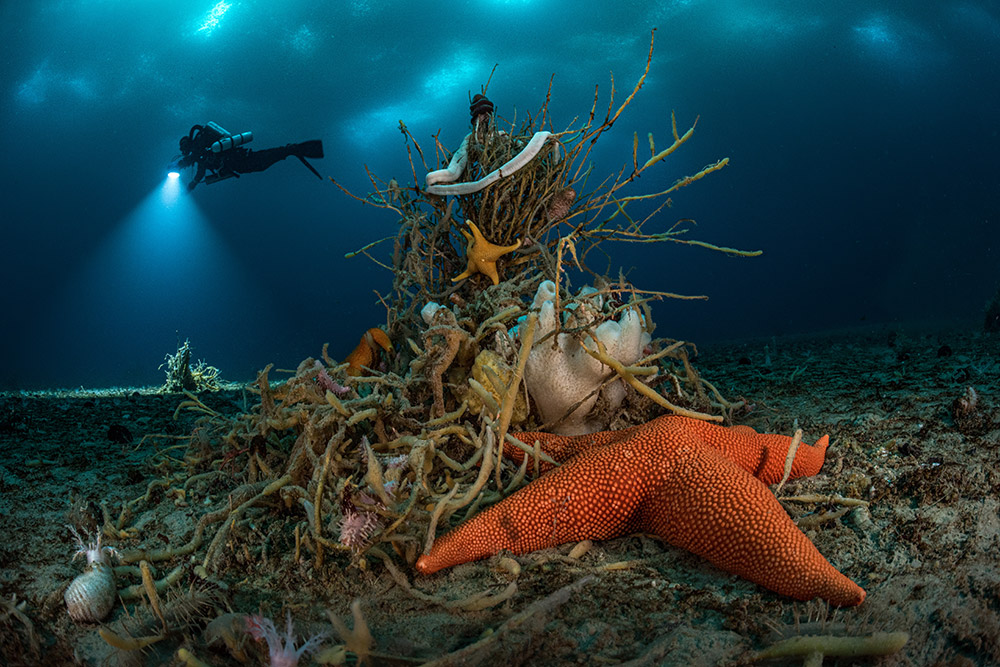
Under Antarctic Ice by Laurent Ballesta, France. Portfolio Award Winner. ‘Pyramid of life’ Living towers of marine invertebrates punctuate the seabed off Adelie Land. 32metres (105 feet) under East Antarctic ice. Here, at the centre, a tree-shaped sponge is draped with life, from giant ribbon worms to sea stars Nikon D810, 13mm f/2.8 lens, 1/13sec at f/16, ISO 800; Seacam housing; 2x Seacam strobes. © Laurent Ballesta/Wildlife Photographer of the Year
Last year’s grand prize winner, Laurent Ballesta, returns for this year’s competition, taking home the Portfolio Award. In this shot – ‘Pyramid of Life’ – living towers of marine invertebrates punctuate the seabed off Adelie Land, 32 metres under East Antarctic ice. At the centre, a tree-shaped sponge is draped with life, from giant ribbon worms to sea stars.
Laurent’s expedition to Antarctica, to explore its vast underwater biodiversity, took two years to plan. It included a team of expert divers and specially developed kit. His 32 dives in water temperature down to -1.7°C included the deepest, longest dive ever made in Antarctica.
Rising Star Portfolio Award
Winner: A theatre of birds by Mateusz Piesiak, Poland
Canon EOS R + 14–35mm f4 lens at 14mm; 1/1000 sec at f10(+0.7 e/v); ISO 500; wireless trigger
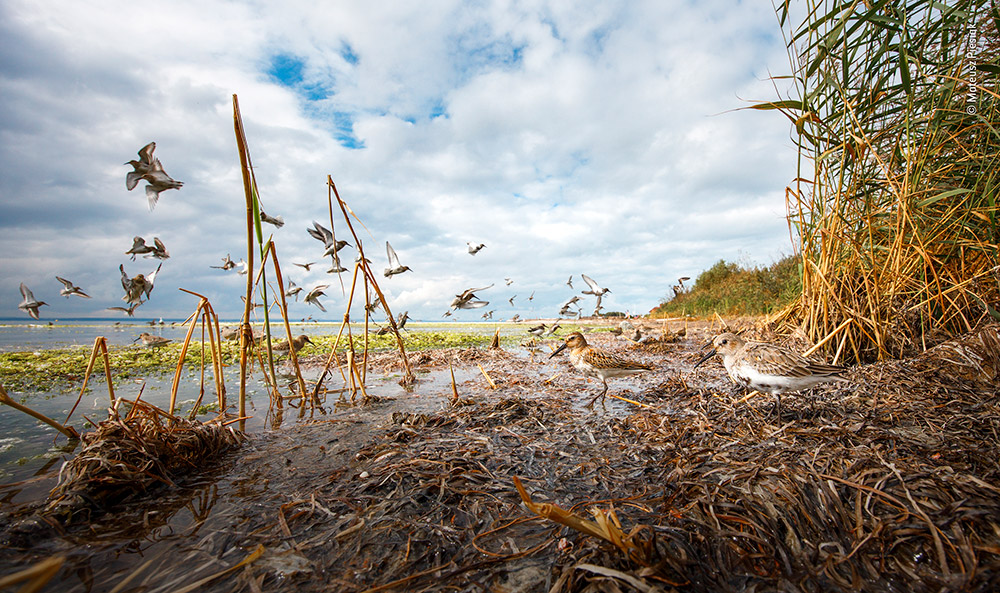
‘A theatre of birds’ by Mateusz Piesiak, Poland. Rising Star Portfolio Award Winner. ‘Dunlin panorama’ Placing his remote camera on the mud of the reed bed, Mateusz seized the opportunity to capture the moment when a passing peregrine falcon caused some of the dunlins to fly up. Canon EOS R + 14–35mm f4 lens at 14mm; 1/1000 sec at f10(+0.7 e/v); ISO 500; wireless trigger. © Mateusz Piesiak/Wildlife Photographer of the Year
Mateusz Piesiak carefully considered camera angles to produce a series of intimate photographs exploring the behaviour of birds. Winner of the Young Wildlife Photographer of the Year award when he was 14, Mateusz explored his locality during the Covid-19 lockdown. ‘Even a small pond or park in the city centre turned out to be a very good place for photographing wildlife.’ Throughout this portfolio Mateusz focuses on local birds. Researching and preparing for images that were in his mind ‘for days, months or even years’ before he finally managed to realise them
Young Wildlife Photographer of the Year
10 Years and under
Winner: Battle Stations by Ekaterina Bee, Italy
Nikon D5600, 18-55mm f/3.5-5.6 lens, 1/320sec at f/9, ISO 100
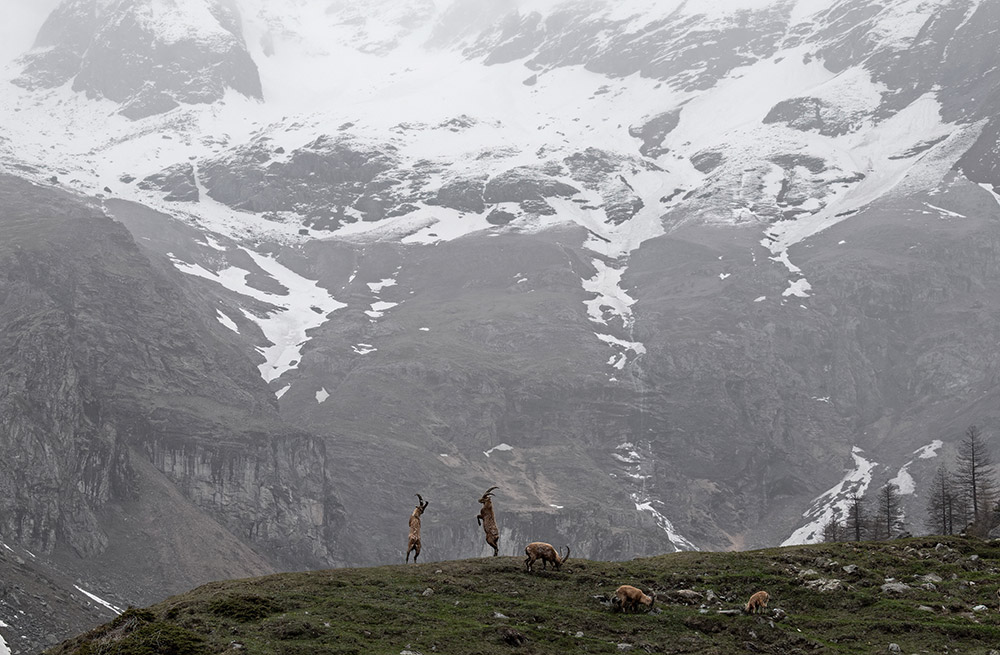
Battle Stations by Ekaterina Bee, Italy. Young Wildlife Photographer of the Year 10 Years and under Winner. Nikon D5600, 18-55mm f/3.5-5.6 lens, 1/320sec at f/9, ISO 100. © Ekaterina Bee/Wildlife Photographer of the Year
Near the end of a spring day trip with her family, young photographer Ekaterina spotted this fight between two Alpine ibex. The two clashed horns and traded blows while standing on their hind legs like boxers.
In the early 1800s, fewer than 100 Alpine ibex survived in the mountains on the Italy-France border thanks to centuries of hunting. Today, successful conservation measures mean that there are now more than 50,000.
11-14 Years
Winner: Out of the fog by Ismael Domínguez Gutiérrez, Spain
Canon EOS 7D Mark II + Tamron 100–400mm f4.5–6.3 lens;1/8000 sec at f6.3; ISO 800; Fancier tripod

Out of the fog by Ismael Domínguez Gutiérrez, Spain. Young Wildlife Photographer of the Year 11-14 Years Winner. Canon EOS 7D Mark II + Tamron 100–400mm f4.5–6.3 lens;1/8000 sec at f6.3; ISO 800; Fancier tripod. © Ismael Domínguez Gutiérrez/Wildlife Photographer of the Year
Ismael Domínguez Gutiérrez reveals a monochromatic scene as an osprey sits on a dead tree, waiting for the fog to lift. When Ismael arrived at the wetland, he was disappointed not to be able to see beyond a few metres. He certainly had no hope of glimpsing the grebes he wanted to photograph. But as the fog began to lift, it revealed the opportunity for this striking composition. Ospreys are winter visitors to the province of Andalucía. Here the many reservoirs offer these widespread fish‑eating raptors shallow, open water that is clearer than many rivers and lakes.
Wildlife Photographer of the Year 58 exhibition at Natural History Museum
A redesigned exhibition featuring all of the awarded images will open at the Natural History Museum in London on Friday 14th October. The flagship show will now include short videos, quotes from jury members and photographers. Plus insights from the scientists who work at the museum. Visitors are invited to explore how our human actions have an impact on the natural world. The London exhibition closes in July 2023 and will then tour across the rest of the UK. As well as to international venues across Europe and the rest of the world.
- Open Friday 14 October 2022 and closes Sunday 2 July 2023.
- The exhibition is open Monday – Sunday, 10.00-17.50 (last admission at 16.30), and weekends sell out quickly.
- Adult tickets from £17.00*, concession tickets £13.50*, and child £10.25* (*Prices excluding optional Gift Aid donation to the Museum.) Book your tickets here.
- The exhibition was designed by a team led by RIBA Stirling Prize winning Witherford Watson Mann architects. We worked with graphic design studio Wolfe Hall, and Lightheory Studio, TM Lighting and Fine Art Lighting.
Use #WPY58 on social media.
Enter the 59th Wildlife Photographer of the Year competition
Inspired by the images you see here? Enter the 59th edition of the Wildlife Photographer of Year competition.
- Opens for entries on Monday 17 October 2022 and closes at 11.30am GMT on Thursday 8 December 2022.
- Entrants to the adult competition may enter up to 25 images for a £30 fee. This increases to £35 in the final week of the entry period from 11.30am GMT 1 December to 11.30am GMT 8 December.
- An entry fee waiver has been introduced for photographers entering the adult competition who live in these 50 countries.
- Entrants aged 17 and under may enter up to 10 images for free.
Visit nhm.ac.uk/wpy/competition for more information and full rules.
See more competitions to enter here






